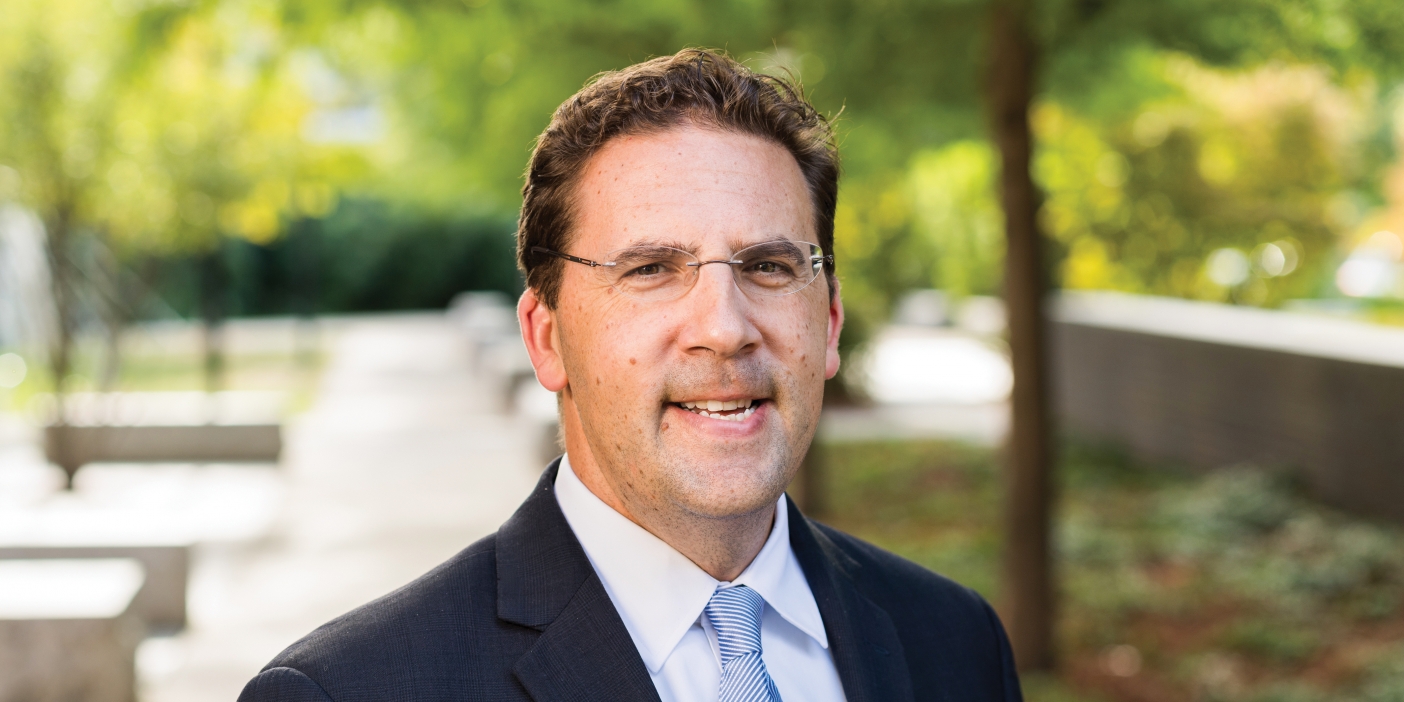Physics, animation, DNA, and grammar—it's all in a day's work for BYU's five supercomputers named Mary Lou. Together they daily juggle trillions of tasks, helping students and professors give form to their ideas.
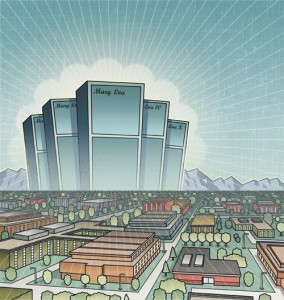
She can be an intimidating presence. At the top of BYU’s computing hierarchy, Mary Lou wields phenomenal power, keeps a mind-boggling schedule, and resolves staggering problems in seconds. Her net worth easily tops $30 million, and she spends her days in a glass-walled office on the top floor of the Crabtree Technology Building, secured by two sets of code-locked doors. Yet her virtual door opens readily for any student who needs her help with high-tech research.
Mary Lou, of course, is a computer. Actually, she’s five computers. Actually, she’s five supercomputers (Mary Lou, Mary Lou 1, Mary Lou 2, Mary Lou 10, and Mary Lou X), and her office is a climate-controlled environment where she knocks tasks off her to-do list by the trillions. With the ability to process more than one teraflop—a trillion calculations per second—by herself, Mary Lou X ranks as one of the 200 most powerful computers in the world. As a group, the five machines can compute two teraflops, and to tap that power a student only needs a valid project and a faculty mentor’s support. In fact, students make up two-thirds of BYU supercomputer users, and half of those are undergraduates.
That such speedy technology contributes to undergraduate-student projects makes Ira Fulton, the donor of the supercomputers, happy. Undergraduate access is rare in the world of academic supercomputing, and free access, like that at BYU, is almost unheard of. Fulton, husband of the flesh-and-blood Mary Lou, understands the value of student exposure to supercomputers, and he wants BYU to make sure Mary Lou’s 788 processors have time in their schedules for undergraduates.
Students make up two-thirds of BYU supercomputer users, and half of those are undergraduates.
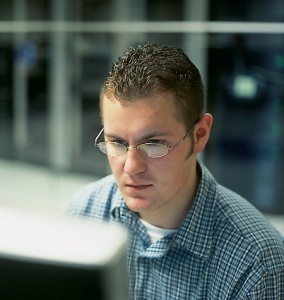
Many a student résumé has been enhanced by Mary Lou. For example, a 2002–03 animation class used Mary Lou to create a short film called Lemmings. So impressive is the final product that one animation studio, with a policy of not hiring recent graduates, grabbed four recent BYU graduates who worked on Lemmings; a fifth received three job offers in three days and is now working on the next Star Wars movie.
None of that would have happened without Mary Lou and her open-door policy.
The following sections offer an overview of Mary Lou’s portfolio—the power she possesses, the projects she facilitates, and the computing history she follows—as well as a glimpse at the Mary Lous of the future.
ARTICLE CREDITS: Text by Heather M. Danforth, ’03, Peter B. Gardner, ’98, Jeffrey S. McClellan, ’94, Michael R. Walker, ’90, and B. Robert Zawrotny, ’04. Photography by Bradley H. Slade, ’94. “Building BYU’s Portfolio” illustrations courtesy of various BYU entities; satellite image courtesy of NASA. All other illustrations by Peter Hoey.
FEEDBACK: Send comments on this article to magazine@byu.edu.
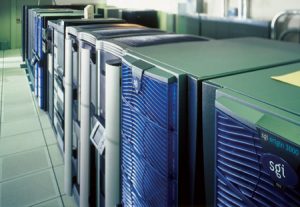
BYU’S SUPER POWER
Housed in more than a dozen refrigerator-sized cabinets, BYU’s five supercomputers named Mary Lou possess phenomenal power that students and professors regularly tap for learning and research.
Computing Comparsions
The Competition
According to the official supercomputer ratings (November 2003), Mary Lou X is the 177th most powerful computer in the world. Her peers include the fastest supercomputers in the country of Oman (ranked 168), Charles Schwab company (172), Dell Computer offices (176), and NASA’s Jet Propulsion Laboratory (179).
In U.S. higher education, only 18 schools have faster computers. Virginia Tech has the fastest academic computer. Also boasting top-25 campus computers are Cornell, Pennsylvania State, and the University of Utah.
Mary Lou X has more power than the top computer at the U.S. Department of the Treasury (208), BMW (226), Sprint PCS (268), and AT&T (456). She can also outrun any supercomputer in eastern Europe, South America, and Africa.
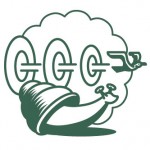
Terabyte Speed
BYU’s speediest computer, Mary Lou X, can perform 1 trillion calculations per second. That is around 1,500 times more than your computer at home, which can likely do about 700 million calculations per second. The same ratio describes the relative speeds of a cruising peregrine falcon and a creeping garden snail.
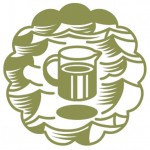
Olympic-Sized Memory
Imagine pouring lemonade from a pitcher while soaking in a hot tub after swimming laps in an Olympic-sized swimming pool. The volume of the pool compares to Mary Lou 10’s 348 gigabytes of random-access memory (RAM). That is about 2,700 times greater than your home computer’s 128 megabytes, which is comparable to the hot tub. The pitcher in your hand represents early PCs with 256 kilobytes of RAM, about 1.36 million times less than Mary Lou 10.

Processor Teamwork
If one fence-post installer digs 316 holes by himself, how long does it take? A long time. But if he brings along his 315 closest friends, the job goes quickly—like turning your data-heavy project over to Mary Lou 10’s 316 processors instead of sweating along with the single processor of a personal computer.
Power Users
An Arizona home builder and businessman, Ira Fulton sees his gifts as investments rather than donations. And he watches his BYU investments carefully.
In donations and grants alone, the supercomputing-center investment has generated more than 10 times its value. A year ago the presence of supercomputers helped lure to BYU a software and hardware donation valued at more than $300 million from PACE, an alliance of GM, EDS, and Sun Microsystems. The supercomputers have also enabled researchers to pull in more than $8 million in grants from sources with acronyms like NSF, NIH, and NASA, and BYU supercomputer projects have caught the attention of the National Weather Service, Pixar, and Nature magazine.
The eight projects featured here are a sampling of the work done on the supercomputers by scholars across campus.
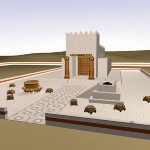
Ancient Temples Initiative
History and Ancient Scripture
A three-dimensional, interactive tour of Solomon’s ancient temple, created by BYU students and scholars, allows visitors to explore a building that hasn’t been seen for more than 2,500 years. Without a single stone or artifact from the original structure, researchers used biblical texts and comparative studies of art and architecture to create the model. BYU has created a similar tour of Herod’s Temple.
Analogical Language Modeling
Linguistics
Relying on Mary Lou’s vast memory, researchers predict language usage in the same way people learn it—with examples rather than rules.
BYU professors feed Mary Lou tens of thousands of real-life word combinations, from which they predict combinations that would be appropriate in new situations. The technique is having success predicting usage in languages that have never been described by rules.
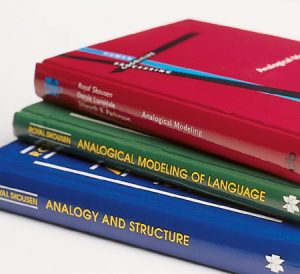
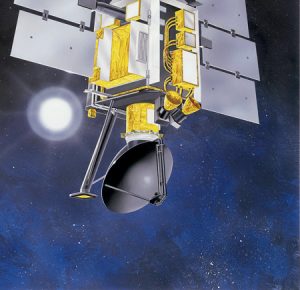
Microwave Earth Remote Sensing
Electrical and Computer Engineering
Every week NASA sends Professor David G. Long, ’82, and his students radar images of the earth from satellites and other sensors. This information is processed by the supercomputers and made available to NASA and the National Ice Center. The data shows changes in ocean winds, tropical vegetation, and polar ice, allowing a more detailed understanding of the earth’s surface.
Gas-Phase Molecular Recognition
Chemistry and Biochemistry
Using Mary Lou, researchers are calculating the shapes of molecules and learning how they fit together. “This is really neat chemistry,” says David V. Dearden, ’83, associate professor of chemistry and biochemistry. “Knowing how these molecules fit together is important for designing, purifying, and detecting more effective drugs and for eventually building molecule-sized machines and computing hardware.
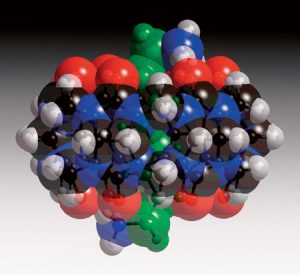
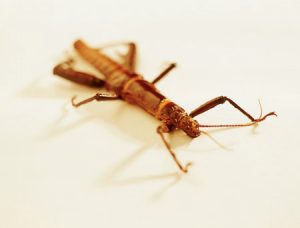
Insect Phylogenomics
Integrative Biology
In January 2003, Nature and National Geographic reported BYU’s remarkable discovery of the re-evolution of wings by certain species of walking sticks. Michael F. Whiting, ’90, an associate professor of integrative biology, and his students made the discovery when they analyzed the DNA sequences of 35 species of walking sticks, using the supercomputers to compare relationships among the insects. computational fluid dynamics for renewable energy Chemical Engineering more.byu.edu/fluiddynamics With the help of the supercomputers, this team simulates the environments inside huge furnaces that produce electrical power, process materials in large industries, and make steam for industrial and residential use. They use complex, detailed computations to search for the root causes of problems like corrosion, pollutant emissions, and inefficient fuel conversion.
Lemmings
Industrial Design
Lemmings, a five-minute student-created animated film, has received multiple film-festival awards since its completion in mid-2003. R. Brent Adams, associate professor of industrial design, says that without the supercomputers the lemmings would have been bald. “I don’t have to apologize to the students for the lack of tools that they really need to create a portfolio they’re proud of. I’ll never have to say ‘pretend like we’ve got real computers.

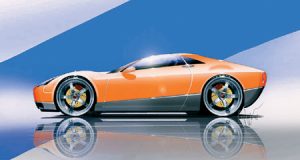
3-D Automotive Visualizations
Industrial Design and Mechanical Engineering
Using top-of-the-line software and the IRA virtual reality theater, BYU students have revved up their automobile designs and plans with interactive 3-D models. Supercomputer-related software and hardware worth $313.
8 million, donated by GM, EDS, and Sun Microsystems, help students prepare to race into the workforce.
Sharper Visions
Deep in the bowels of BYU’s Crabtree Technology Building, clouds swarm as a complex model of tornado velocity vectors swirls in the air. The twister disappears before your eyes, and the next thing you know, a car floats in front of you, spinning on its axis.
No, it’s not magic. These images are made possible through the fiber-optic cables that link the SGI Onyx 2 supercomputer to BYU’s state-of-the-art virtual reality theater. Among those who benefit from its use are animation and industrial design students who model cars, boats, motors, and arctic rodents in three dimensions.
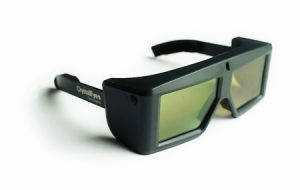
Employees who know how to use this technology can save companies millions of dollars in design costs and time to market.
The small movie-theater-like facility seats up to 25 people, who simply slip on special polarized eyeglasses to create the 3-D effect. The theater is equipped with Dolby Digital Surround Sound and twin high-resolution projectors.
Affectionately dubbed IRA (Interactive Reality Auditorium) after Ira Fulton, who donated $1 million to build the facility, the theater adds another dimension to learning and prepares students to make real contributions in their fields.
Employees who know how to use this technology can save companies millions of dollars in design costs and time to market, says industrial design associate professor R. Brent Adams. “The ability to examine designs in three dimensions, to almost sense how a product will feel, can allow product managers to narrow down the design pool immediately without proceeding with further research and work on impractical designs.
The Supercomputer in the Palm of Your Hand
The computing capability that filled a room a decade ago now slips easily into your pocket. That trend will continue—the machines that calculate and simulate will continue to get faster, smaller, and cheaper.
“Supercomputers are predictors of what we will have on our desk or lap in 10 years,” says computer science professor Dan R. Olsen Jr., ’76. “In 10 years your laptop will be 100 times faster than it is now with 100 times more memory and 1,000 times more disk space, with no increase in cost. That is about the size of our current supercomputer.
“Every few years, some in the computer industry express concern that they are reaching the limits of silicon, that the chips simply don’t have the physical capacity to do more. But someone always finds a solution, and expressing information digitally will go forward whether it uses a circuit created on an artificial diamond surface or even one fashioned from individual atoms.
“Computing is fundamentally about information,” says Olsen, referring to the 1s and 0s—on and off switches—that form the foundation of digital computing. “You can compute with any physics that can differentiate between two states. Thus computing is quite independent of the physics used. We are a very long way from ‘hitting the wall’ in finding physics that will differentiate a 0 from a 1. The silicon chips of today were just as vague to us in 1980 as carbon nanotubes are today.
“In just a few years, BYU students will likely have constant access to wireless digital libraries, sleek interactive electronic textbooks, and live video lectures to enhance their education. Perhaps, like the students who today use the virtual reality auditorium on campus, students campuswide will participate in lectures punctuated with manipulatable 3-D models floating above the room.
As research aids, Olsen says computers of the future will be programmed to learn and evolve on their own, developing the ability to find not only the answers but also the questions. “Increasingly scientists will guide computers to discover problems,” he predicts.
But as with supercomputers today, what the computers of tomorrow will enable us to do is more significant than the machines themselves. “We’ve got a lot of new research topics as a result of the supercomputer,” says David G. Long, ’82, a professor of electrical and computer engineering. “I consider that actually more valuable than having this enormous computer to be doing it on. Having the computer has freed up our thinking and enabled us to develop whole new sets of ideas and ways to solve problems.
Mary Lou’s Roots
1952 | BYU purchases an IBM 602-A Calculator for the Treasurer’s Office. The calculator can perform 200 calculations per second.
1958 | BYU rents a nearly three-ton IBM 650 mainframe doing 700 calculations per second. Over the next 15 years, upgrades raise BYU’s centralized computing power to 1.25 million calculations per second.
1961 | The engineering department buys a Bendix G15, beginning decentralized campus computing. By 1975 BYU has some 30 “minicomputers” across campus.
1969 | The Computer Science Department is created to accommodate rapidly growing student interest.
1972 | BYU implements computer registration, allowing students to mail in class requests. In 1984 BYU creates the nation’s first computerized Touch-Tone phone-registration system. By 1999 students register via the Internet.
1977 | BYU buys two Apple IIes, two TRS-80s, and two Commodore PETs, new desktop computers. By 2004 BYU owns more than 8,500 desktop computers.
1986 | The BYU library moves its post-1978 catalog to computers with BYLINE.
1993 | BYU creates its first Web server, later adding a home page (1994) and giving all students free e-mail addresses and Internet access (1997).
1998 | BYU decommissions its last mainframe computer, in part to become Y2K compliant.
1999 | Ira Fulton donates Mary Lou, an SGI Onyx2 Origin 2000 supercomputer. Over the next four years, Fulton donates four more supercomputers.
2002 | PACE, a partnership of GM, EDS, and Sun Micro- systems, gives BYU a software and hardware package worth $313.8 million.
A Half-Century of Computing at BYU
By Peter B. Gardner, (BA ’98)
Over the past 50 years, computers at BYU have risen from big and basic to quick and compact, culminating in BYU’s five supercomputers.
1952 | BYU purchases an IBM 602-A calculator for use in the treasurer’s office. The calculator can add, subtract, multiply, divide, and perform 200 calculations per second.
1953 | BYU offers its first class in machine accounting.
1953 | IBM ships its first electronic computer, the 701.
July 1953 | IBM releases the 650 Magnetic Drum Data Processing Machine, its first commercial business computer. The nearly 3-ton machine becomes famous for its adaptability and many blinking lights.
1955 | BYU’s Data Processing Department is created.
1958 | BYU announces its acquisition of an “electronic brain,” a rented IBM 650. The computer can perform 700 calculations per second.
1960 | BYU purchases an IBM 650 and creates the Computer Research Center in the basement of the new Jesse Knight Humanities Building.
1961 | The first integrated circuit on a chip is introduced.
1961 | The Department of Engineering Sciences purchases a Bendix G15 for college computing.
1963 | Leading computer technician Gary Carlson joins BYU.
1963 | BYU leases a 9-ton IBM 7040 mainframe computer for administrative and academic research computing. It can perform 62,000 calculations per second.
1964 | A prototype is created for the computer mouse, which would not be used widely until the release of the Apple Macintosh in 1984.
1964 | BYU finds itself in the national spotlight for its annual IBM dance, where couples are matched according to preferences by a computer, after the program lined up a brother/sister date.
1965 | A program on the IBM 7040 out-prognosticates sports writers and coaches on sporting events.
1967 | Two Librascope L-3055s are acquired for the Department of Physics and the College of Engineering Sciences.
1968 | BYU computer science course enrollments increase 1,000 percent since 1963, 20 times faster than university enrollment growth over the same period.
1968 | BYU purchases a massive IBM 360/50 mainframe for administrative and research use. It can perform some 500,000 calculations per second.
1969 | BYU’s Computer Science Department is created.
1971 | IBM creates the first floppy diskette, an 8-inch data-storage medium.
1971 | BYU’s IBM 360/50 is moved to a 4,000 square-foot, climate-controlled room in the newly completed Talmage Building. Some 40 terminals around campus make remote access possible.
1972 | Home video and arcade games hit the market with the release of the Magnavox Odyssey and the Atari Pong, respectively.
1972 | BYU begins implementing computer registration, allowing students to mail in class requests to be processed by the computer.
1973 | BYU begins using DEC-10 and IBM 7030 “Stretch” computers for research and educational purposes.
1973 | BYU upgrades the IBM 360/50 to an IBM 360/65, which can perform 1.25 million calculations a second.
1974 | BYU purchases a Microdata minicomputer for use in the BYU Bookstore.
1974 | BYU programmer Gwen Wiser creates a program for BYU football defensive coach Tom Ramage to analyze opposing teams’ play calling. The program would later be adopted by the rest of the football coaching staff.
1975 | By mid-1975, BYU had approximately 30 minicomputers in departments across campus, making administration and research more efficient.
1976 | BYU civil engineering professors Henry N. Christiansen and Michael B. Stephenson license MOVIE-BYU, an inexpensive program for rendering 3-D images. It would be used by thousands of research laboratories, universities, and government organizations.
1977 | BYU buys two Apple IIes, two TRS-80s, and two Commodore PETs, newly released desktop computers, for testing.
1979 | BYU professor Alan Ashton and BYU grad Bruce Bastian incorporate Satellite Software International, later WordPerfect.
1980 | The first laser discs are developed by Philips.
1981 | The IBM PC is released.
1983 | Based on BYU-created library programming, a team of former BYU staff and grads James Wilson, Paul Sybrowski, Keith Wilson, and Ralph Egan create DYNIX, now the world’s largest library-automation company.
1984 | BYU creates the nation’s first computerized Touch Tone-phone-registration system, making registration quick and available anywhere.
1984 | Sony announces the first 3 1/2-inch floppy drives and diskettes.
1984 | Philips and Sony introduce the CD-ROM.
1985 | “Elrond,” a computer-aided instruction program, teaches Computer Science 103, an introductory course in computing.
1986 | The Harold B. Lee Library’s circulation, ordering, and post-1978 catalog listings go online with the Brigham Young Libraries Information Network (BYLINE).
1986 | BYU licenses its “WordCruncher” program, developed by James S. Rosenvall and Monte F. Shelly of the Department of Instructional Applications Services. The program makes it possible to search large texts for specific words or phrases and is used by many publishers to create electronic texts.
1989 | IBM and BYU team up to study how supercomputers can increase the efficiency of BYU software applications in engineering optimization and advanced computer graphics. BYU is granted use of an IBM 3090.
1990 | The World Wide Web is born when Tim Berners-Lee develops Hypertext Markup Language (HTML).
1993 | BYU assistant professor of computer science Phillip J. Windley sets up BYU’s first Web server.
1994 | Kiosk workstations are placed across campus, giving students access to many campus services.
1994 | BYU launches its first official home page.
1997 | BYU begins offering its first Internet course: Religion C 324, Doctrine and Covenants.
1997 | E-mail addresses and access to the Internet are made available for free to all BYU students through Route Y.
1998 | BYU decommissions its last mainframe computer, an IBM 3090 400e, in part to become Y2K compliant.
1999 | Students are able to register on the Internet. Touch Tone-phone registration would be entirely phased out in 2001.
1999 | Ira Fulton donates Mary Lou, a SGI Onyx2 Origin 2000 supercomputer. Within the year, the computer is upgraded twice to hold 112 processors, 60 gigabytes of RAM, and about 1.75 terabytes of hard-drive space. It is upgraded again in 2003.
2000 | BYU adopts the Blackboard online course-management program, allowing faculty to create class Web pages to facilitate teaching and learning.
2000 | Mary Lou 1 and Mary Lou 2 supercomputers are purchased; they are upgraded in spring 2002.
2001 | An IBM SP-2 supercomputer is purchased; it is upgraded and expanded in 2002.
2001 | Using a $200,000 Pew Grant, BYU English faculty redesign English 115 to be a hybrid course, taught part in class and part online.
2001 | A BYU independent-study course is developed to be taken using a personal digital assistant (PDA). It is believed to be the first independent-study course ever created for a PDA.
2002 | PACE, a consortium of auto and technology companies GM, EDS, and Sun Microsystems, gives BYU a software and hardware package worth $313.8 million—BYU’s largest corporate gift ever—in large part because of BYU’s supercomputing power.
2003 | The Mary Lou X supercomputer is purchased and is upgraded later that year.







